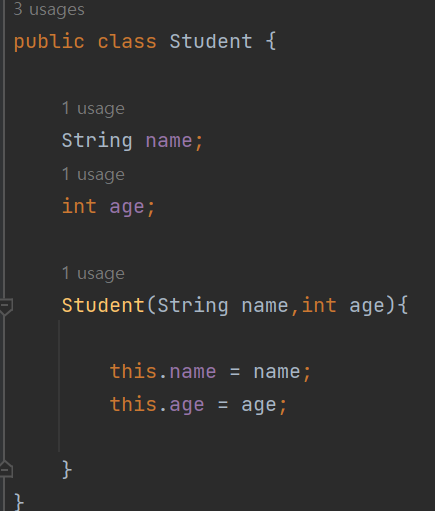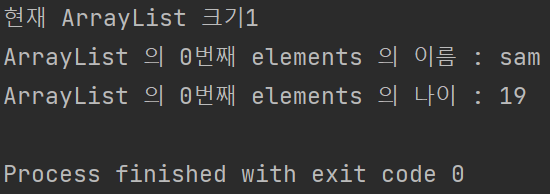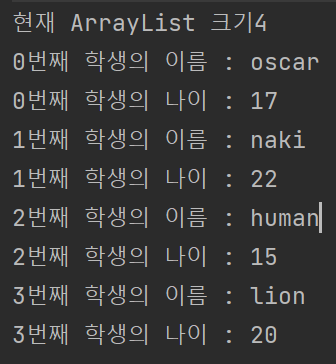| 일 | 월 | 화 | 수 | 목 | 금 | 토 |
|---|---|---|---|---|---|---|
| 1 | 2 | 3 | 4 | 5 | 6 | |
| 7 | 8 | 9 | 10 | 11 | 12 | 13 |
| 14 | 15 | 16 | 17 | 18 | 19 | 20 |
| 21 | 22 | 23 | 24 | 25 | 26 | 27 |
| 28 | 29 | 30 | 31 |
- java thread 예제
- 디자인 패턴 예제
- recyclerview item recycle
- edittext 연결
- Kotlin
- savedinstancestate
- dagger error
- 변수
- AAC
- hilt error
- 안드로이드 스튜디오 tts
- Thread
- 자바 스레드 예제
- 객체지향 프로그래밍 5가지 원칙
- 안드로이드 스튜디오 인터넷 연결 확인
- apache nginx
- 리사이클러뷰 아이템 재사용
- java
- 아파치 엔진엑스
- 안드로이드 스튜디오 custom dialog
- 이중for문 사용 안하기
- LifeCycle
- 안드로이드 디자인패턴
- 안드로이드 스튜디오 인터넷 연결 안되어 있을 때
- 안드로이드 스튜디오 반복되는 레이아웃 코드
- apache란
- 안드로이드 스튜디오 style
- 안드로이드 스튜디오 커스텀 다이얼로그
- 아파치란
- 다른 객체 리스트의 비교
- Today
- Total
Sam Story
JAVA - ArrayList 사용 본문
오늘은 자바 ArrayList에 대해서 포스팅 해보려한다.
안드로이드 스튜디오나 자바를 사용하다보면 ArrayList를 사용할일이 빈번한데
간단하게 사용법을 알아보도록 하자.
1. 생성 및 초기화
자바에서 ArrayList를 사용하려면 먼저 아래 코드를 import 해주어야 한다.
import java.util.ArrayList;
간단한 데이터클래스를 만들고 진행해 보도록 하겠다.

위 코드는 이름과 나이를 갖고 있는 Student 클래스 이다.
import java.util.ArrayList;
public class Main {
public static void main(String[] args) {
ArrayList<Student> studentArrayList = new ArrayList<>();
}
}
위 양식처럼 클래스 이름을 <> 안에 넣어서 <> 안에 있는 객체의 ArrayList를 생성 및 초기화 할 수 있다.
그런 후에 실제로 ArrayList 의 값을 추가하고 불러와 보자.
import java.util.ArrayList;
public class Main {
public static void main(String[] args) {
ArrayList<Student> studentArrayList = new ArrayList<>();
// student 객체 생성 및 초기화
Student student = new Student("sam",19);
// studentArrayList에 student 객체 추가
studentArrayList.add(student);
// ArrayList의 크기 구하는 메서드
System.out.println("현재 ArrayList 크기" + studentArrayList.size());
// ArrayList의 특정 index 값을 가져올 때
System.out.println("ArrayList 의 0번째 elements 의 이름 : " + studentArrayList.get(0).name);
System.out.println("ArrayList 의 0번째 elements 의 나이 : " + studentArrayList.get(0).age);
}
}

student 객체를 하나 만들어서
만들어준 studentArrayList에 add() 라는 메서드를 사용해 리스트에 추가해 주었다.
ArrayList는 기본 내장되어 있는 배열과는 다르게 크기를 정해주지 않아도 된다는 특징이 있다.
크기를 정해주지 않기 때문에 초기화 한 시점에서 size는 0 부터 시작하게 되고
add 를 해줄 때마다 ArrayList의 사이즈가 1씩 늘어난다.
위 내용을 토대로 아래의 예제를 보자.
import java.util.ArrayList;
public class Main {
public static void main(String[] args) {
ArrayList<Student> studentArrayList = new ArrayList<>();
// 배열에 들어갈 객체 생성
Student student1 = new Student("sam",19);
Student student2 = new Student("oscar",17);
Student student3 = new Student("naki",22);
Student student4 = new Student("human",15);
Student student5 = new Student("lion",20);
// 요소 추가
studentArrayList.add(student1);
studentArrayList.add(student2);
studentArrayList.add(student3);
studentArrayList.add(student4);
studentArrayList.add(student5);
System.out.println("현재 ArrayList 크기" + studentArrayList.size());
// 배열 순회
for (int i = 0; i < studentArrayList.size(); i++) {
System.out.println(i+"번째 학생의 이름 : " + studentArrayList.get(i).name);
System.out.println(i+"번째 학생의 나이 : " + studentArrayList.get(i).age);
}
}
}
이처럼 추가해준 요소 개수에 따라 ArrayList의 사이즈가 늘어난걸 예제에서 볼 수 있다.
그리고 일반 배열과는 다르게 ArrayList는 요소를 제거하는것도 가능하다.
import java.util.ArrayList;
public class Main {
public static void main(String[] args) {
ArrayList<Student> studentArrayList = new ArrayList<>();
// 배열에 들어갈 객체 생성
Student student1 = new Student("sam",19);
Student student2 = new Student("oscar",17);
Student student3 = new Student("naki",22);
Student student4 = new Student("human",15);
Student student5 = new Student("lion",20);
// 요소 추가
studentArrayList.add(student1);
studentArrayList.add(student2);
studentArrayList.add(student3);
studentArrayList.add(student4);
studentArrayList.add(student5);
// 0번째 인덱스의 값 제거
studentArrayList.remove(0);
System.out.println("현재 ArrayList 크기" + studentArrayList.size());
// 배열 순회
for (int i = 0; i < studentArrayList.size(); i++) {
System.out.println(i+"번째 학생의 이름 : " + studentArrayList.get(i).name);
System.out.println(i+"번째 학생의 나이 : " + studentArrayList.get(i).age);
}
}
}

위 실행 결과 대로 요소를 제거하게 되면 ArrayList의 사이즈도 줄어들게 되고 실제로 배열을 순회 했을때
기존 0번째 인덱스에 있던 값이 제거되고 1번째부터 인덱스가 하나씩 당겨지는걸 볼 수 있다.
이러한 ArrayList를 사용하면 일반 배열과는 다르게 좀더 유동적으로 데이터들을 관리할 수 있고
다양한 로직을 짤때도 크게 도움이된다.
'JAVA' 카테고리의 다른 글
| JAVA - 배열 요소의 내림차순,오름차순 (0) | 2024.03.23 |
|---|---|
| JAVA - 문자열 자르기 Split (0) | 2024.03.17 |
| JAVA - Class 란? (0) | 2024.01.28 |
| JAVA - 반복문( for문 , while문) (1) | 2024.01.14 |
| JAVA - 변수 (자료형) (0) | 2023.10.31 |


